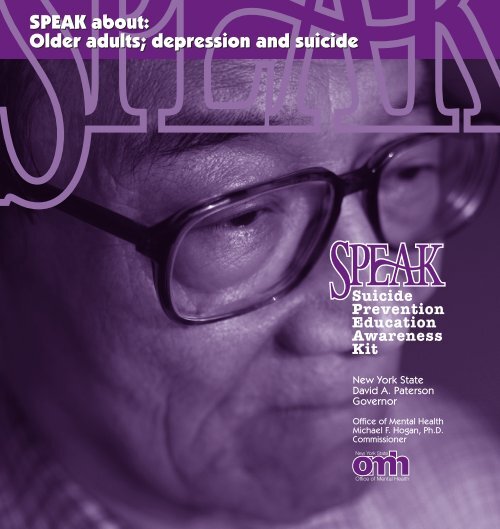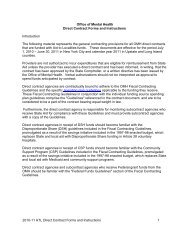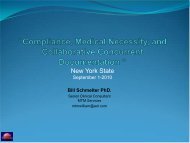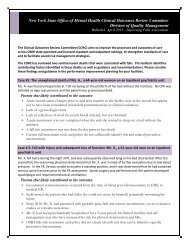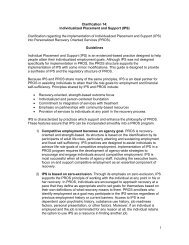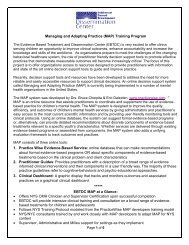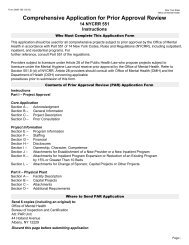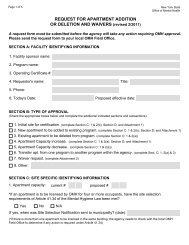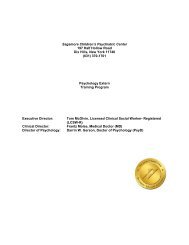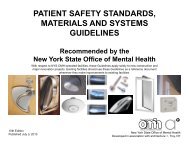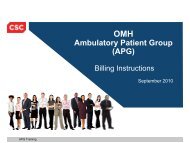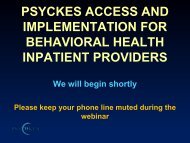SPEAK about: Older adults - New York State Office of Mental Health
SPEAK about: Older adults - New York State Office of Mental Health
SPEAK about: Older adults - New York State Office of Mental Health
Create successful ePaper yourself
Turn your PDF publications into a flip-book with our unique Google optimized e-Paper software.
<strong>SPEAK</strong> <strong>about</strong>:<br />
<strong>Older</strong> <strong>adults</strong>; depression and suicide<br />
Suicide<br />
Prevention<br />
Education<br />
Awareness<br />
Kit<br />
<strong>New</strong> <strong>York</strong> <strong>State</strong><br />
David A. Paterson<br />
Governor<br />
<strong>Office</strong> <strong>of</strong> <strong>Mental</strong> <strong>Health</strong><br />
Michael F. Hogan, Ph.D.<br />
Commissioner
<strong>SPEAK</strong> <strong>about</strong>: <strong>Older</strong> <strong>adults</strong>, depression and suicide 1<br />
Speak <strong>about</strong>:<br />
<strong>Older</strong> Adults; Depression<br />
and Suicide Facts<br />
DEPRESSION, one <strong>of</strong> the most common conditions associated with<br />
suicide in older <strong>adults</strong>, 1 is a widely underrecognized and undertreated<br />
medical illness. In fact, several studies have found that many<br />
older <strong>adults</strong> who die by suicide—up to 75 percent—have visited a primary care<br />
physician within a month <strong>of</strong> their suicide. 2 These findings point to the urgency<br />
<strong>of</strong> improving detection and treatment <strong>of</strong> depression as a means <strong>of</strong> reducing suicide<br />
risk among older persons.<br />
<strong>Older</strong> Americans are disproportionately likely to die by suicide. Comprising only<br />
13 percent <strong>of</strong> the U.S. population, individuals age 65 and older accounted for 18<br />
percent <strong>of</strong> all suicide deaths in 2000. Among the highest rates (when categorized<br />
by gender and race) were white men age 85 and older: 59 deaths per<br />
100,000 persons in 2000, more than five times the national U.S. rate<br />
<strong>of</strong> 10.6 per 100,000. 3<br />
Of the nearly 35 million Americans age 65 and older, an estimated<br />
2 million have a depressive illness (major depressive disorder,<br />
dysthymic disorder, or bipolar disorder) and another 5<br />
million may have “subsyndromal depression,” or depressive<br />
symptoms that fall short <strong>of</strong> meeting full diagnostic criteria for a<br />
disorder. 4,5 Subsyndromal depression is especially common<br />
among older persons and is associated with an increased risk<br />
<strong>New</strong> <strong>York</strong> <strong>State</strong> <strong>Office</strong> <strong>of</strong> <strong>Mental</strong> <strong>Health</strong>
2 <strong>SPEAK</strong> <strong>about</strong>: <strong>Older</strong> <strong>adults</strong>, depression and suicide<br />
<strong>of</strong> developing major depression. 6 In any <strong>of</strong> these forms, however, depressive<br />
symptoms are not a normal part <strong>of</strong> aging. In contrast to the normal emotional<br />
experiences <strong>of</strong> sadness, grief, loss, or passing mood states, they tend to be persistent<br />
and to interfere significantly with an individual’s ability to function.<br />
Depression <strong>of</strong>ten co-occurs with other serious illnesses such as heart disease,<br />
stroke, diabetes, cancer, and Parkinson’s disease. 7 Because many older <strong>adults</strong><br />
face these illnesses as well as various social and economic difficulties, health<br />
care pr<strong>of</strong>essionals may mistakenly conclude that depression is a normal consequence<br />
<strong>of</strong> these problems—an attitude <strong>of</strong>ten shared by patients themselves. 8<br />
These factors together contribute to the underdiagnosis and undertreatment <strong>of</strong><br />
depressive disorders in older people. Depression can and should be treated<br />
when it co-occurs with other illnesses, for untreated depression can delay<br />
recovery from or worsen the outcome <strong>of</strong> these other illnesses. The relationship<br />
between depression and other illness processes in older <strong>adults</strong> is a focus <strong>of</strong><br />
ongoing research.<br />
Both doctors and patients may have difficulty identifying the signs <strong>of</strong> depression.<br />
NIMH-funded researchers are currently investigating the effectiveness<br />
<strong>of</strong> a depression education intervention delivered in primary care clinics for<br />
improving recognition and treatment <strong>of</strong> depression and suicidal symptoms<br />
in elderly patients. 9<br />
Research and Treatment<br />
Research has revealed varying patterns <strong>of</strong> clinical and biological features<br />
among older <strong>adults</strong> with depression. 8 As compared to older persons whose<br />
depression began earlier in life, those whose depression first appears in late life<br />
are likely to have a more chronic course <strong>of</strong> illness. In addition, there is growing<br />
evidence that depression beginning in late life is associated with vascular<br />
changes in the brain.<br />
Both antidepressant medications and short-term psychotherapies are effective<br />
treatments for late-life depression. 8 Existing antidepressants are known to influence<br />
the functioning <strong>of</strong> certain neurotransmitters in the brain. The newer medications,<br />
chiefly the selective serotonin reuptake inhibitors (SSRIs), are generally<br />
preferred over the older medications, including tricyclic antidepressants (TCAs)<br />
<strong>New</strong> <strong>York</strong> <strong>State</strong> <strong>Office</strong> <strong>of</strong> <strong>Mental</strong> <strong>Health</strong>
<strong>SPEAK</strong> <strong>about</strong>: <strong>Older</strong> <strong>adults</strong>, depression and suicide 3<br />
and monoamine oxidase inhibitors (MAOIs), because they have fewer and less<br />
severe potential side effects. 10 Both generations <strong>of</strong> medications are effective in<br />
relieving depression, although some people will respond to one type <strong>of</strong> drug,<br />
but not another.<br />
Research has shown that certain types <strong>of</strong> short-term psychotherapy, particularly<br />
cognitive-behavioral therapy and interpersonal therapy, are effective treatments<br />
for late-life depression. 8 In addition, psychotherapy alone has been shown to<br />
prolong periods <strong>of</strong> good health free from depression. Combining psychotherapy<br />
with antidepressant medication, however, appears to provide maximum benefit.<br />
In one study, approximately 80 percent <strong>of</strong> older <strong>adults</strong> with depression<br />
recovered with combination treatment. 11 The combination treatment was also<br />
found to be more effective than either treatment alone in reducing recurrences<br />
<strong>of</strong> depression. 12<br />
More studies are in progress on the efficacy and longer-term effectiveness <strong>of</strong><br />
SSRIs and specific psychotherapies for depression in older persons. Findings<br />
from these studies will provide important data regarding the clinical course and<br />
treatment <strong>of</strong> late-life depression. Further research will be needed to determine<br />
the role <strong>of</strong> hormonal factors in the development <strong>of</strong> depression in older <strong>adults</strong>,<br />
and to find out whether hormone replacement therapy with estrogens or<br />
androgens is <strong>of</strong> benefit in the treatment <strong>of</strong> late-life depression.<br />
The <strong>New</strong> <strong>York</strong> <strong>State</strong> <strong>Office</strong> <strong>of</strong> <strong>Mental</strong> <strong>Health</strong> thanks the National<br />
Institute <strong>of</strong> <strong>Mental</strong> <strong>Health</strong> for providing the information contained<br />
in this booklet.<br />
For more information, write or call the <strong>Office</strong> <strong>of</strong> <strong>Mental</strong> <strong>Health</strong><br />
Community Outreach & Public Education <strong>Office</strong>, 44 Holland<br />
Avenue, Albany NY 12229, 866-270-9857 (English only, toll<br />
free), or visit the <strong>SPEAK</strong> website at www.speakny.org<br />
<strong>New</strong> <strong>York</strong> <strong>State</strong> <strong>Office</strong> <strong>of</strong> <strong>Mental</strong> <strong>Health</strong>
4 <strong>SPEAK</strong> <strong>about</strong>: <strong>Older</strong> <strong>adults</strong>, depression and suicide<br />
References<br />
1 Conwell Y, Brent D. Suicide and aging. I: patterns <strong>of</strong> psychiatric diagnosis. International Psychogeriatrics,<br />
1995; 7(2): 149-64.<br />
2 Conwell Y. Suicide in later life: a review and recommendations for prevention. Suicide and Life<br />
Threatening Behavior, 2001; 31(Suppl): 32-47.<br />
3 <strong>Office</strong> <strong>of</strong> Statistics and Programming, NCIPC, CDC. Web-based Injury Statistics Query and Reporting<br />
System (WISQARSTM): http://www.cdc.gov/ncipc/ wisqars/default.htm.<br />
4 Narrow WE. One-year prevalence <strong>of</strong> depressive disorders among <strong>adults</strong> 18 and over in the U.S.: NIMH<br />
ECA prospective data. Unpublished table.<br />
5 Alexopoulos GS. Mood disorders. In: Sadock BJ, Sadock VA, eds. Comprehensive Textbook <strong>of</strong> Psychiatry,<br />
7th Edition, Vol. 2. Baltimore: Williams and Wilkins, 2000.<br />
6 Horwath E, Johnson J, Klerman GL, Weissman MM. Depressive symptoms as relative and attributable<br />
risk factors for first-onset major depression. Archives <strong>of</strong> General Psychiatry, 1992; 49(10): 817-23.<br />
7 Depression Guideline Panel. Depression in primary care: volume 1. Detection and diagnosis. Clinical<br />
practice guideline, number 5. AHCPR Publication No. 93-0550. Rockville, MD: Agency for <strong>Health</strong> Care,<br />
Policy and Research, 1993.<br />
8 Lebowitz BD, Pearson JL, Schneider LS, Reynolds CF 3rd, Alexopoulos GS, Bruce ML, Conwell Y, Katz IR,<br />
Meyers BS, Morrison MF, Mossey J, Niederehe G, Parmelee P. Diagnosis and treatment <strong>of</strong> depression in<br />
late life. Consensus statement update. Journal <strong>of</strong> the American Medical Association, 1997; 278(14):<br />
1186-90.<br />
9 Bruce ML, Pearson JL. Designing an intervention to prevent suicide: PROSPECT (Prevention <strong>of</strong> Suicide in<br />
Primary Care Elderly: Collaborative Trial). Dialogues in Clinical Neuroscience, 1999; 1(2): 100-12.<br />
10 Reynolds CF 3rd, Lebowitz BD. What are the best treatments for depression in old age? The Harvard<br />
<strong>Mental</strong> <strong>Health</strong> Letter, 1999; 15(12): 8.<br />
11 Little JT, Reynolds CF 3rd, Dew MA, Frank E, Begley AE, Miller MD, Cornes C, Mazumdar S, Perel JM,<br />
Kupfer DJ. How common is resistance to treatment in recurrent, nonpsychotic geriatric depression?<br />
American Journal <strong>of</strong> Psychiatry, 1998; 155(8): 1035-8.<br />
12 Reynolds CF 3rd, Frank E, Perel JM, Imber SD, Cornes C, Miller MD, Mazumdar S, Houck PR, Dew MA,<br />
Stack JA, Pollock BG, Kupfer DJ. Nortriptyline and interpersonal psychotherapy as maintenance therapies<br />
for recurrent major depression: a randomized controlled trial in patients older than 59 years. Journal<br />
<strong>of</strong> the American Medical Association, 1999; 281(1): 39-45.<br />
<strong>New</strong> <strong>York</strong> <strong>State</strong> <strong>Office</strong> <strong>of</strong> <strong>Mental</strong> <strong>Health</strong>
First printed May 2004, revised March 2007


